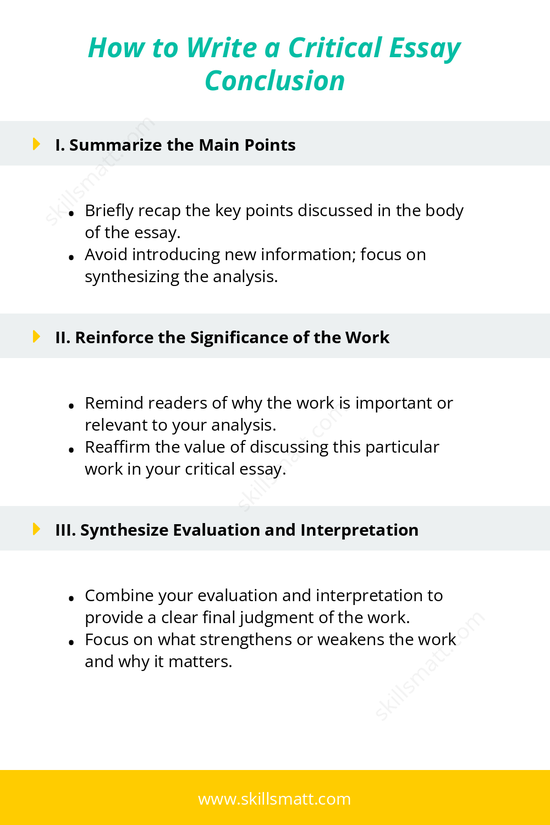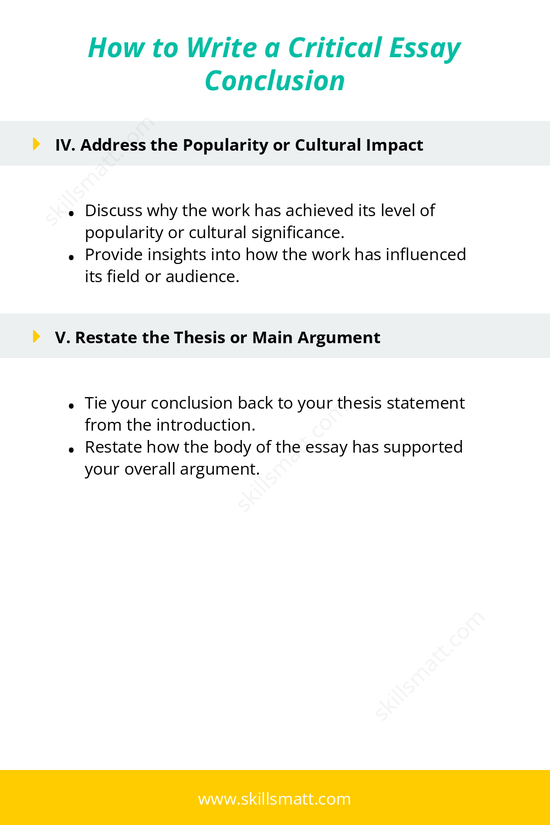How to Write a Critical Essay Conclusion
I. Summarize the Main Points
- Briefly recap the key points discussed in the body of the essay: In the conclusion, briefly summarize the main arguments or points you've made throughout the essay. Revisit the key elements of your analysis, but avoid repetition of lengthy details from the body paragraphs.
- Avoid introducing new information; focus on synthesizing the analysis: The conclusion should not include new arguments or details. Instead, synthesize the points made earlier, providing a cohesive final perspective on the work analyzed.
II. Reinforce the Significance of the Work
- Remind readers of why the work is important or relevant to your analysis: Highlight the significance of the work in relation to the themes you’ve discussed. Remind the reader why analyzing this particular work adds value to the broader field of study or discussion.
- Reaffirm the value of discussing this particular work in your critical essay: Emphasize the relevance of the work’s themes or messages to the contemporary or historical context, underlining its importance in the larger conversation.
III. Synthesize Evaluation and Interpretation
- Combine your evaluation and interpretation to provide a clear final judgment of the work: The conclusion is where you tie together your evaluation of the work, summarizing both its strengths and weaknesses. Provide a clear, final judgment of the work based on your previous analysis.
- Focus on what strengthens or weakens the work and why it matters: Discuss how your evaluation of strengths and weaknesses reflects the overall impact or effectiveness of the work, and why these aspects are significant in the larger context of your essay’s argument.
IV. Address the Popularity or Cultural Impact
- Discuss why the work has achieved its level of popularity or cultural significance: Consider the work’s place within its genre, audience reception, or impact on culture. Reflect on how the work’s popularity or cultural relevance affects its interpretation or analysis.
- Provide insights into how the work has influenced its field or audience: Share insights about the cultural or historical significance of the work and its broader effects on its audience or the field of study.
V. Restate the Thesis or Main Argument
- Tie your conclusion back to your thesis statement from the introduction: Conclude by tying back to your thesis, reminding the reader of your main argument. Show how the analysis throughout the body has supported the thesis.
- Restate how the body of the essay has supported your overall argument: Briefly restate the key ways in which your body paragraphs have backed up your thesis, bringing the critical analysis to a satisfying and conclusive end.


